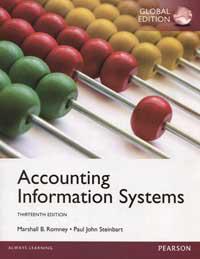1.Integrated chapter-opening cases introduce important material and reinforce key concepts.
2.A real-world view in the focus boxes and real-world examples help students understand how companies are using the latest IT developments to improve their AIS.
3.Up-to-date information covers critical topics
4.Students get numerous opportunities to practice and hone their skills, and check themselves for understanding:
•Hands-on Excel exercises, many based on “how-to” tutorials that appeared in recent issues of the Journal of Accountancy, help readers hone their computer skills.
•Numerous problems in every chapter provide additional opportunities to demonstrate mastery of key concepts.
•Cases in each chapter encourage reader to delve deeper into specific topics.
•Chapter quizzes let readers self assess their understanding of the material. Detailed explanations about the correct answer to each quiz question are provided.
•Extensive use of graphics enhances students’ understanding of the concepts through hundreds of figures, diagrams, flowcharts, and tables.
5.Instructors get the flexibility to tailor the material to fit their individual course needs.
•Chapters can be easily reordered to focus on the material most appropriate to individual courses.
| FindBook |
|
有 1 項符合
marshall b romney的圖書 |
 |
$ 1260 | Accounting Information Systems (GE)
作者:Marshall B Romney、Paul J Steinbart 出版社:華泰文化 出版日期:2014-09-10 語言:英文  看圖書介紹 看圖書介紹
|
|
|
圖書介紹 - 資料來源:博客來 評分:
圖書名稱:Accounting Information Systems (GE) 13/e
內容簡介
作者介紹
作者簡介
Marshall B Romney
現職:
Brigham Young University
Paul J Steinbart
現職:
Arizona State University
Marshall B Romney
現職:
Brigham Young University
Paul J Steinbart
現職:
Arizona State University
目錄
Part I: Conceptual Foundations of Accounting Information Systems
Ch 1 Accounting Information Systems: An Overview
Ch 2 Overview of Transaction Processing and Enterprise Resource Planning Systems
Ch 3 Systems Documentation Techniques
Ch 4 Relational Databases
Part II: Control and Audit of Accounting Information Systems
Ch 5 Computer Fraud
Ch 6 Computer Fraud and Abuse Techniques
Ch 7 Control and Accounting Information Systems
Ch 8 Controls for Information Security
Ch 9 Confidentiality and Privacy Controls
Ch10 Processing Integrity Availability Controls
Ch11 Auditing Computer-Based Information Systems
Part III: Accounting Information Systems Applications
Ch12 The Revenue Cycle: Sales to Cash Collections
Ch13 The Expenditure Cycle: Purchasing to Cash Disbursements
Ch14 The Production Cycle
Ch15 The Human Resources Management and Payroll Cycle
Ch16 General Ledger and Reporting System
Part IV: The REA Data Model
Ch17 Database Design Using the REA Data Model
Ch18 Implementing an REA Data Model in a Relational Database
Ch19 Special Topics in REA Modeling
Part V: The Systems Development Process
Ch20 Introduction to Systems Development; Systems Analysis
Ch21 AIS Development Strategies
Ch22 Systems Design, Implementation, and Operation
Ch 1 Accounting Information Systems: An Overview
Ch 2 Overview of Transaction Processing and Enterprise Resource Planning Systems
Ch 3 Systems Documentation Techniques
Ch 4 Relational Databases
Part II: Control and Audit of Accounting Information Systems
Ch 5 Computer Fraud
Ch 6 Computer Fraud and Abuse Techniques
Ch 7 Control and Accounting Information Systems
Ch 8 Controls for Information Security
Ch 9 Confidentiality and Privacy Controls
Ch10 Processing Integrity Availability Controls
Ch11 Auditing Computer-Based Information Systems
Part III: Accounting Information Systems Applications
Ch12 The Revenue Cycle: Sales to Cash Collections
Ch13 The Expenditure Cycle: Purchasing to Cash Disbursements
Ch14 The Production Cycle
Ch15 The Human Resources Management and Payroll Cycle
Ch16 General Ledger and Reporting System
Part IV: The REA Data Model
Ch17 Database Design Using the REA Data Model
Ch18 Implementing an REA Data Model in a Relational Database
Ch19 Special Topics in REA Modeling
Part V: The Systems Development Process
Ch20 Introduction to Systems Development; Systems Analysis
Ch21 AIS Development Strategies
Ch22 Systems Design, Implementation, and Operation
|










